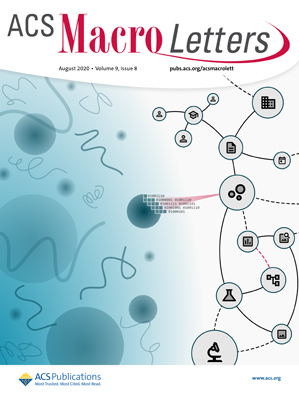金属超分子聚合物系统的光触发开关。
IF 5.2
Q1 POLYMER SCIENCE
引用次数: 0
摘要
金属超分子聚合物(MSPs)是通过含有多个配体和合适金属盐的单体之间形成配位配合物而形成的。MSPs的组装通常是动态的和可逆的,这导致刺激响应材料,并使功能,如愈合或回收。热可以说是最广泛使用的刺激来操纵msp,但可以实现的控制水平是有限的。在这里,我们报告光响应MSP系统,其响应是基于光化学转导原理。我们将光酸生成剂2-(4-甲氧基苯乙烯基)-4,6-二(三氯甲基)-1,3,5-三嗪(MBTT)与含有几摩尔%的2,6-二(1'-甲基苯并咪唑基)吡啶(Mebip)配体的聚丙烯酸酯结合。后者在加入金属盐(如Zn2+、Eu3+和Cu2+)后形成超分子交联。我们利用滴定实验、光谱学以及模型化合物和聚合物系统的流变学来证明,由于配体的质子化和ML复合物的解离,MSP网络可以在光酸发生器的光学激活下快速分解。光流变学实验表明,基于MSP网络、MBTT和氯苯的凝胶在紫外线照射下可以按需改变其流变学特性。本文章由计算机程序翻译,如有差异,请以英文原文为准。
Light-Triggered Switching of Metallosupramolecular Polymer Systems.
Metallosupramolecular polymers (MSPs) are formed through the formation of coordination complexes between monomers that contain multiple ligands and suitable metal salts. The assembly of MSPs is generally dynamic and reversible, which leads to stimuli-responsive materials and enables functions such as healing or recycling. Heat is arguably the most widely employed stimulus to manipulate MSPs, but the level of control that can be achieved is limited. Here, we report light-responsive MSP systems, whose response is based on an opto-chemical transduction principle. We combined the photoacid generator 2-(4-methoxystyryl)-4,6-bis(trichloromethyl)-1,3,5-triazine (MBTT) with poly(acrylates) that comprise a few mol % of the 2,6-bis(1'-methyl-benzimidazolyl)pyridine (Mebip) ligand. The latter forms supramolecular cross-links upon the addition of metal salts, such as Zn2+, Eu3+, and Cu2+. We utilized titration experiments, optical spectroscopy, and rheology on model compounds and polymer systems to demonstrate that the MSP network can be rapidly disassembled upon optical activation of the photoacid generator, on account of protonation of the ligand and dissociation of the ML complex. Optorheological experiments reveal that the rheological properties of gels based on the MSP network, MBTT, and chlorobenzene can be drastically altered in an on-demand fashion by exposure to UV light.
求助全文
通过发布文献求助,成功后即可免费获取论文全文。
去求助
来源期刊
CiteScore
10.40
自引率
3.40%
发文量
209
审稿时长
1 months
期刊介绍:
ACS Macro Letters publishes research in all areas of contemporary soft matter science in which macromolecules play a key role, including nanotechnology, self-assembly, supramolecular chemistry, biomaterials, energy generation and storage, and renewable/sustainable materials. Submissions to ACS Macro Letters should justify clearly the rapid disclosure of the key elements of the study. The scope of the journal includes high-impact research of broad interest in all areas of polymer science and engineering, including cross-disciplinary research that interfaces with polymer science.
With the launch of ACS Macro Letters, all Communications that were formerly published in Macromolecules and Biomacromolecules will be published as Letters in ACS Macro Letters.

 求助内容:
求助内容: 应助结果提醒方式:
应助结果提醒方式:


